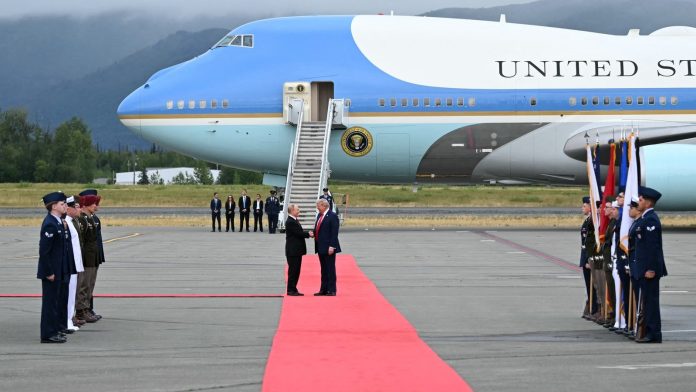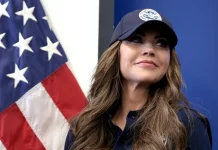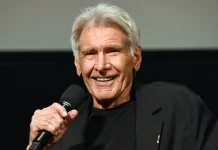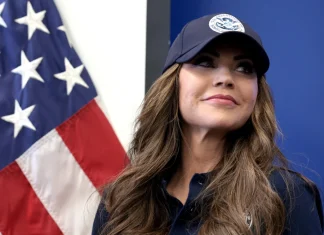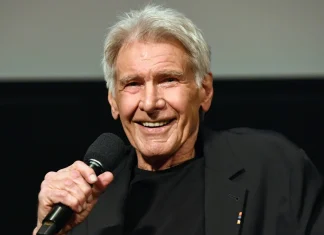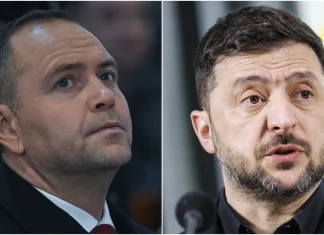A Choreographed Meeting in the Last Frontier: When Putin and Trump Landed in Alaska
Imagine a remote corner of the world, where icy winds sweep through rugged mountains, and the vastness of the wilderness humbles even the mightiest of leaders. This was the backdrop for a moment that felt both surreal and historically charged: Vladimir Putin, the Russian president, touching down on American soil for the first time since launching the devastating invasion of Ukraine, greeted with a spectacle seemingly torn from a diplomatic movie script. And at this juncture stood Donald Trump, the former U.S. president, orchestrating the scene with unmistakable flair.
Elmendorf Air Base in Alaska—once a vital Soviet surveillance hub during the Cold War—is now the stage on which two complex figures confronted not only each other but the weight of history and global tensions. That morning, under a leaden sky more fitting for a stark political drama than a warm reunion, Air Force One and Putin’s Russian plane landed, their arrivals far from accidental symbolism. When Trump clapped for Putin, waiting on the tarmac after a five-year hiatus since their last encounter in 2019, it was a moment dripping with layers of intrigue and unease.
Business-class Brevity and Frozen Smiles: The Summit’s Uneasy Dynamics
The handshake was firm, the smiles perhaps practiced but genuine enough to capture a photographer’s dream. They posed before a sign emblazoned “Alaska 2025,” which many joked seemed more like a campaign slogan than a summit banner. But then something unexpected occurred—a signal of shadowy intimacy in the midst of public spectacle. Putin, normally circumspect and guarded, climbed aboard “The Beast,” the ultra-secure, nearly mythical American presidential limousine, to travel alongside Trump.
It was a historic first and a symbolic gesture laced with irony. For years, the “Beast” has been a rolling fortress, protecting the most powerful figure in the U.S. Now, seated side-by-side in that armored vehicle, the two men shared a rare moment of closeness—and yet, the silence between them was deafening. Putin’s wide grin, a rare crack in his otherwise stone-faced persona, was accompanied by light jokes about his silence to waiting reporters.
The Weight of Consequence: Shadows Behind the Smile
Putin travels sparingly nowadays, with an arrest warrant from the International Criminal Court hanging over him for alleged war crimes committed during the brutal conflict in Ukraine. His very presence on American soil was controversial. When a persistent reporter loudly demanded, “When will you stop killing civilians?” the question hung unanswered, echoing over the frozen Alaskan landscape like a cold wind. Putin said nothing.
Behind the scenes, the Russian delegation bore symbols of a bygone era. Foreign Minister Sergey Lavrov, a man rarely seen without his conservative suit and tie, was spotted wearing a sweatshirt emblazoned “CCCP” — a direct nod to the Soviet Union the Kremlin still nostalgically reveres. For Putin and his circle, reasserting Russian superpower status is not mere rhetoric but a driving force behind their actions.
Diplomacy on Thin Ice: Sanctions, Protests, and Unlikely Accommodations
The U.S. government temporarily eased the debilitating sanctions imposed on Russia since the invasion. This small reprieve allowed the Russian delegation to function within the base’s confines — withdrawing money from ATMs and conducting daily business, a minor but significant nod toward maintaining diplomatic protocol despite ongoing hostilities.
Though neither president was expected to step beyond the base, the spirit of protest found its way to Alaska’s streets and rooftops. Ukrainian flags, a vivid blue-and-yellow display, adorned lamp posts and roofs, designed to catch the eyes of anyone flying into Anchorage. Activists taped signs reminding the world of the human cost of the conflict—one emblazoned a chilling message beside a cold portrait of Putin: “This war criminal kidnaps children.”
The city itself was caught off guard. Anchorage’s hotels had been booked for months by tourists keen to fish in pristine rivers or embark on breathtaking coastal cruises. Few could have anticipated their peaceful getaway turning into the epicenter of global diplomacy. Russian journalists, unprepared for the logistical scramble, found themselves sleeping in a converted sports arena, beds divided by mere black curtains — a stark, almost Kafkaesque, image of journalists forced to camp out in the shadow of international politics.
Serving Symbolism on a Plate: A Taste of Russia in Alaska
In a curious cultural mix, American hosts served the Russian press familiar comfort foods—shashlik, grilled fish, and, poignantly, chicken Kiev. This dish, once a culinary emblem of Ukrainian heritage, took on a bitter irony. It was a subtle reminder that beneath the grand speeches and staged meetings, the war outside the base’s perimeter continued to cast a long shadow.
What This Moment Means: Between Power Plays and Global Tensions
Witnessing the Alaska summit forces us to confront complex narratives. Here, in one of the last wild frontiers of the United States, two conflicting visions of the world met under tense yet oddly civil circumstances. Was this a genuine attempt to “pursue peace” — a phrase emblazoned in the meeting room but placed only in English, perhaps symbolizing dialogue’s limits? Or simply a theater of power, where appearances must be maintained despite deep divides?
Observers around the globe asked themselves: What does it mean when a Russian leader, accused of horrific crimes, can walk briefly into a limousine designed to protect an American president? Does it signal a thaw, or is it merely a brief interlude before the next act of geopolitical chess? And for the people suffering amidst the war—the civilians in Ukraine, the displaced families, the children lost—does such a meeting bring hope, or only cold comfort?
Looking Ahead: Alaska, Diplomacy, and the Human Story
As Alaska’s glaciers silently shift and its salmon swim upstream, the summit’s reverberations will unfold in ways we cannot yet predict. Diplomacy is often messy, patched with symbolism and irony, punctuated by hope and heartbreak alike. For the citizens of Ukraine, it’s a reminder that alongside official dialogues exist streets covered in tears, cities shattered by shelling, and families trapped between front lines.
For American citizens and the global community, the summit challenges us to consider the balancing act between engagement and accountability — between seeking dialogue with adversaries and standing strong for justice. How do nations reconcile the necessity of conversation with the imperative to uphold human rights?
And for readers here, far from Alaska’s snowfields, the question lingers: In an increasingly interconnected world, how much weight should we place on these carefully staged moments? Can the coldness of diplomacy thaw the frozen wounds of war? Or do these orchestrated encounters obscure the urgent human stories beneath the surface?
In the end, Elmendorf Air Base was more than a military outpost—it was a microcosm of our fractured globe, a place where the future was debated against a backdrop of history’s long shadows. As the leaders departed, two questions stayed with those who watched: Will peace rise from the icy expanse? And can the world find its way through the frostbite of conflict toward the warmth of reconciliation?


